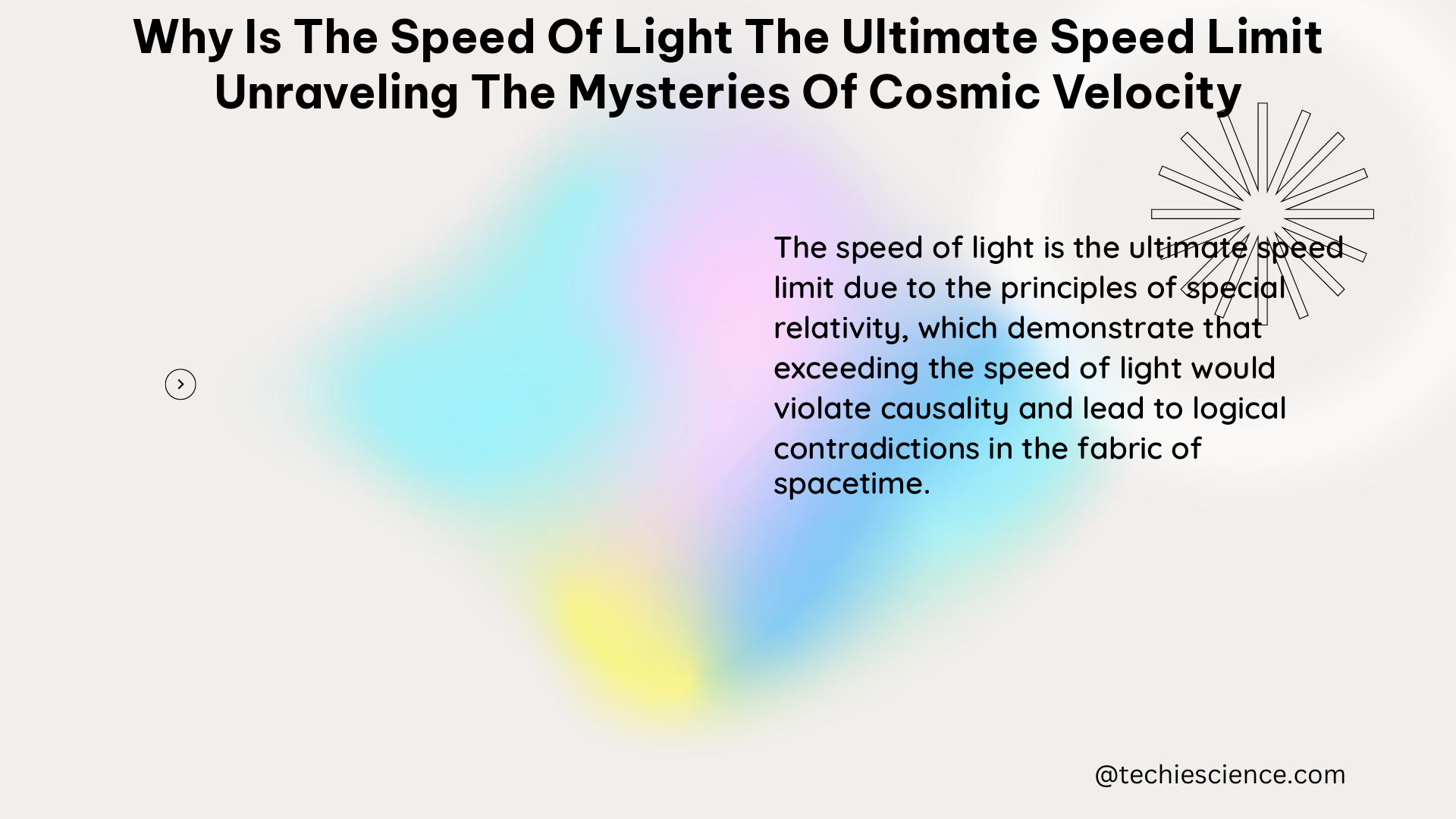The speed of light, denoted as ‘c’, is a fundamental constant in physics that serves as the ultimate speed limit for anything with mass in the universe. This limit arises from the theory of special relativity, developed by Albert Einstein in the early 20th century. As an object with mass approaches the speed of light, its relativistic mass increases, requiring more and more energy to continue accelerating. In fact, to accelerate an object with mass to the speed of light, an infinite amount of energy would be required, which is not practically achievable.
The Lorentz Transformation and the Speed of Light
The speed of light as the ultimate speed limit is a consequence of the Lorentz transformation, a mathematical formula that describes how space and time are affected by relative motion between observers. According to the Lorentz transformation:
x' = γ(x - vt)
t' = γ(t - vx/c^2)
where:
– x and t are the spatial and temporal coordinates of an event in one frame of reference
– x' and t' are the coordinates of the same event in a second frame of reference moving at a velocity v relative to the first frame
– c is the speed of light
– γ is the Lorentz factor, given by:
γ = 1 / sqrt(1 - v^2/c^2)
As the velocity v approaches the speed of light c, the Lorentz factor γ approaches infinity, which means that the length contraction and time dilation become infinite. This effect prevents any object with mass from reaching the speed of light.
The Energy-Momentum Relation and the Speed of Light

The speed of light is also related to the energy-momentum relation, which is given by:
E^2 = (pc)^2 + (mc^2)^2
where:
– E is the energy of the object
– p is its momentum
– m is its rest mass
This equation shows that as the momentum of an object approaches infinity, its energy also approaches infinity, which would require an infinite amount of energy to achieve.
Experimental Evidence for the Constancy of the Speed of Light
The constancy of the speed of light has been demonstrated through various experiments, such as:
-
Michelson-Morley Experiment (1887): This experiment aimed to detect the relative motion of matter through the “luminiferous aether,” a hypothetical medium that was thought to fill the universe and through which light was assumed to propagate. However, the experiment found no difference in the speed of light regardless of the direction of measurement or the motion of the apparatus, contradicting the aether theory.
-
Kennedy-Thorndike Experiment (1932): This experiment measured the speed of light in two perpendicular directions while simultaneously measuring the motion of the apparatus. The experiment found no difference in the speed of light regardless of the motion of the apparatus, further supporting the theory of special relativity.
Implications of the Speed of Light as the Ultimate Speed Limit
-
Information Transfer: According to the theory of relativity, no information can travel faster than the speed of light. This fact has important implications for causality, as it prevents events from influencing each other instantaneously across space.
-
Behavior of Matter and Energy at High Energies: The speed of light has implications for the behavior of matter and energy at very high energies, such as those found in cosmic rays and particle accelerators. At these energies, the effects of special relativity become more pronounced, and the behavior of matter and energy becomes increasingly relativistic.
Conclusion
The speed of light is the ultimate speed limit in the universe, a fundamental constant that arises from the theory of special relativity. This limit has been demonstrated through various experiments and has important implications for the behavior of matter, energy, and information in the cosmos. Understanding the theoretical and experimental foundations of the speed of light as the ultimate speed limit is crucial for unraveling the mysteries of cosmic velocity and advancing our understanding of the physical world.
References:
– “The speed of light is the same no matter how fast you are going.” Reddit, 3 Nov. 2023, www.reddit.com/r/AskPhysics/comments/17mebzi/i_have_small_question_about_speed_of_light_being/.
– “Why is the speed of light a random finite number?” West Texas A&M University, 7 Feb. 2024, www.wtamu.edu/~cbaird/sq/2024/02/07/why-is-the-speed-of-light-a-random-finite-number/.
– “Why the Speed of Light is the Ultimate Speed Limit – YouTube.” YouTube, uploaded by The Physics of the Universe, 2 Oct. 2022, www.youtube.com/watch?v=RcJokUVjYjU.
– “The only way to beat the speed of light – Big Think.” Big Think, 20 July 2022, bigthink.com/starts-with-a-bang/beat-the-speed-of-light/.

The lambdageeks.com Core SME Team is a group of experienced subject matter experts from diverse scientific and technical fields including Physics, Chemistry, Technology,Electronics & Electrical Engineering, Automotive, Mechanical Engineering. Our team collaborates to create high-quality, well-researched articles on a wide range of science and technology topics for the lambdageeks.com website.
All Our Senior SME are having more than 7 Years of experience in the respective fields . They are either Working Industry Professionals or assocaited With different Universities. Refer Our Authors Page to get to know About our Core SMEs.